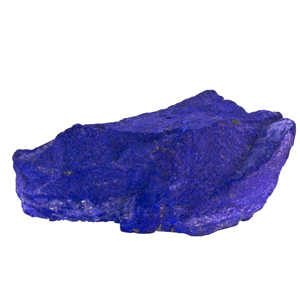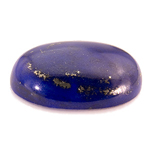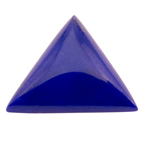Lapis Lazuli
Lapis lazuli, or short lapis, is not a mineral but a rock consisting mainly of lazurite, to which it owes the blue colour, calcite and pyrite. Other constituents may be sodalite, diopside, enstatite, augite, hauyin, mica, hornblende (tremolite) and a few more.

Origin of name: Llapis is the Latin word for "stone" and lazuli is the genitive form of the Medieval Latin lazulum, which is taken from the Arabic لازورد lāzaward, itself from the Persian لاژورد lāžaward, the name of a place where lapis lazuli was mined. Taken as a whole, lapis lazuli means "stone of Lāzhward".
The name of the place came to be associated with the stone mined there and, eventually, with its color. The French azur, the Italian azzurro, the Polish lazur, Romanian azur and azuriu, and the Portuguese and Spanish azul, Hungarian azúr are cognates.
Source: Wikipedia
Synonyms and trade names: none
Can be confused with: sodalite, lazulite, azurite and dumortierite.
Near the German Nunkirchen a fine-grained greyish brown jasper is found which, dyed with prussian blue, was marketed as "German Lapis" or "Swiss Lapis".
Moreover a few artificial products were produced which still may be encountered on the market.
In the 1950ies the German Degussa company produced a cobalt-coloured synthetic spinel. Ocassionally gold flakes were added to imitate the pyrite inclusions in natural lapis lazuli. Reportedly it was technically impossible to add the much cheaper pyrite.
In the 1980ies the Swiss Gilson company produced a material which was marketed as "Synthetic Lapis" although actually it was an imitation, containing constituents not present in genuine lapis. Physical properties like specific gravity and refractive index also differed from the real thing. Gilson's "lapis" was available in different qualities, with and without pyrite.
Localities: since about 7000 years the most important sources by far for finest quality lapis lazuli are the mines near Sar-e-Sang in Badakhshan province in northeastern Afghanistan.


Lapis lazuli from Afghanistan
The triangle is of the fines quality, superb, homogenous blue, no calcite or pyrite inclusions
Other important sources are the Lake Baikal area in Russia and the Coquimbo Region in Chile. Because of its high calcite content, Chilean lapis mostly comes in a mottled blue and white colour.
Lapis is also found in Burmy (Myanmar), Tadjikistan, Pakistan, India and in the USA but none of these localities has any commercial importance.
Handling: lapis lazuli is very brittle. Set and polish with care.
Unfortunately it is also very porous. To protect the surface, lapis is sometimes impreganted with wax or resin but nevertheless contact with any liquid except pure water is to be avoided. All kinds of acids and brines, perfume, creams and lotions, hair spray, insect repellent and human sweat (necklaces!) may ruin the colour.
Lapis lazuli is a popular stone for engravings. However, should you actually want to use your signet ring with the engraved coat-of-arms for sealing, lapis, due to it´s porosity, is a not the best choice. We recommend the classic layer agate or other quartzes like cornelian, onyx or heliotrope (blood stone).
Worth knowing: Lapis lazuli may well be the oldest gem stone used by mankind. The mines in Afghanistan are known to have been worked as long as 6000, possibly even 7000 years ago!
In ancient Egypt lapis lazuli was the most popular stone for amulets and scarabs. It was also highly appreciated in Mesopotamia. In the Babylonian Epic of Gilgamesh, one of the oldest literary texts known to us, it is mentioned on the first table (Take and read out from the lapis lazuli tablet how Gilgamesh went through every hardship). Sumerians, Akkadians and Assyrians used lapis lazuli for seals and jewellery.
For thousands of years lapis lazuli was the main source for the highly priced ultramarine colour, which was used in paintings as well as in cosmetics. Cleopatra is said to have used lapis lazuli eyeshadow.
Its usage in the fine arts only ended in the 19th century, when synthetic ultramarine colours became available.
In 1838 a certain Johannes Zeltner founded the Nuremberg Ultramarine Factory and on July 2nd of 1877 Zeltner applied for a patent for his Process for the production of red ultramarine colour, the first patent ever to be granted in Germany
Quellen: Wikipedia, and Deutsches Patent- und Markenamt, press release June 2002
 Deutsch
Deutsch